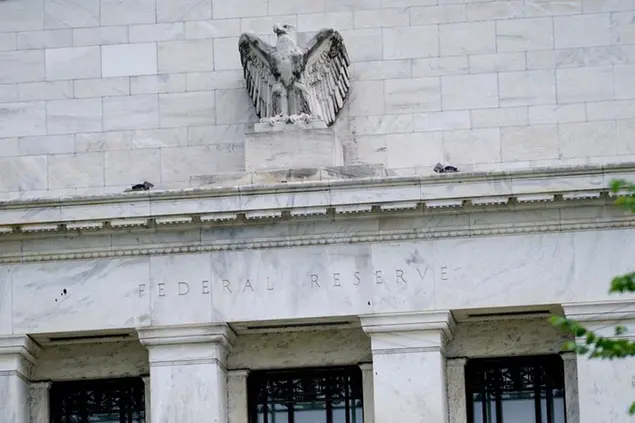PHOTO
The Federal Reserve is expected to hold interest rates steady at a two-day policy meeting this week but open the door to interest rate cuts as soon as September by acknowledging inflation has edged nearer to the U.S. central bank's 2% target.
Policymakers in advance of the July 30-31 meeting were reluctant to commit to the timing of a first rate cut, but audibly cheered recent data showing price pressures were easing broadly, with headline inflation moving closer to the Fed's target and evidence from job, housing and other markets suggesting that trend would continue.
Data on Friday showed the Fed's preferred personal consumption expenditures price index, which was accelerating by as much as 7.1% on a year-over-year basis in 2022, rose by 2.5% in June after a 2.6% gain in May. Since March, in fact, the annualized month-to-month changes in the PCE price index show it rising at just 1.5% - half a percentage point below the Fed's target. A companion measure stripping out volatile food and energy prices is trending at 2.3% over that same window - within sight of the 2% goal.
Combined with a broader sense that price pressures are easing, that data may be enough for Fed officials to change their description of inflation as "elevated" in next week's policy statement, and note rising confidence that the pace of price increases will return to 2%. Policymakers have said they should start cutting interest rates before inflation fully returns to their target, and if upcoming data stays in line with recent months they may be running out of time.
The Fed "is only 50 basis points from the target ... so it seems that is not very far," said Jim Bullard, the former president of the St. Louis Fed and now dean of Purdue University's Mitchell E. Daniels Jr. School of Business.
"Is it still elevated? Sure. But it is not as elevated as it was," Bullard said. A slight change in the statement, perhaps describing it as "moderately elevated," would "send a major signal to markets that you are taking on board all that disinflation that has occurred over the last year and you think it is for real and you don't think it is going to turn around."
The Fed lifted its benchmark interest rate to slow the economy after inflation surged, and has held it steady in the current 5.25%-to-5.50% range since last July, making the current run of tight monetary policy among the longest in recent decades.
Despite warnings last year that such strict financial conditions could trigger a recession, the Fed at least for now appears to have hit a sweet spot. Inflation has fallen, and while the unemployment rate has risen gradually it remains, at 4.1%, around what many Fed officials see as representing full employment.
Some data, including disappointing recent home sales and rising loan delinquencies, may point to weakness. But the most recent report on overall economic output was surprisingly strong, with growth at a 2.8% annualized rate in the second quarter. The Fed regards the economy's underlying potential growth, consistent with stable inflation, at about 1.8%.
"They have had encouraging inflation data ... Clearly the economy is slowing. The balance of risks is different than it was four months ago. Full stop," said Nathan Sheets, global chief economist at Citi. "It feels like they want to be a little more certain, so signal in July and cut in September."
POLITICAL VIBES
The U.S. central bank will release its latest policy statement at 2 p.m. EDT (1800 GMT) on Wednesday, and Fed Chair Jerome Powell will hold a press conference half an hour later.
Acknowledging that rate reductions are imminent would put the Fed in line with investors who consider it a near certainty that it will deliver at least a quarter-percentage-point cut at the Sept. 17-18 meeting, the first step in reversing the most rapid series of rate increases in four decades.
It would also put the Fed in the spotlight of a tumultuous U.S. presidential race.
Inflation may be less of a centerpiece issue in an election that has included an assassination attempt against former President Donald Trump, the Republican nominee, and the withdrawal from the race of President Joe Biden, who was replaced by Vice President Kamala Harris as the Democrats' presidential nominee.
But Republican lawmakers earlier this month told Powell in a hearing that a rate cut in September could seem like an effort to tilt the playing field against Trump, who installed him as Fed chief early in 2018 only to turn deeply critical of his leadership of the central bank.
Among Fed officials, however, sentiment is broadly shared that inflation is easing, including among some of the central bank's more hawkish voices. Fed Governor Christopher Waller, another Trump appointee, in particular said that inflation data was close to the point where rate cuts would be warranted and the labor market close to the point where the unemployment rate might be at risk of rising fast.
Prices and inflation, meanwhile, may still figure into the election.
In its latest election modeling, Oxford Economics said that how swing voters interpret coming economic data could push them towards Trump and the Republicans if they still "fixate on the level of prices and how much they have risen," or towards Harris and the Democrats if they "focus on recent trends in inflation and the low level of unemployment."
Fed rate cuts could be felt quickly on that front, potentially translating into lower borrowing costs for home mortgages, credits cards, and an array of household and business financial products.
(Reporting by Howard Schneider; Editing by Dan Burns and Paul Simao)
